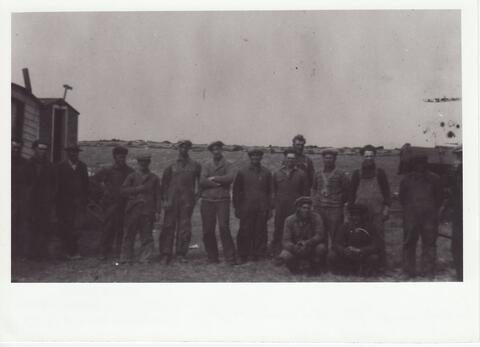
Zone du titre et de la mention de responsabilité
Titre propre
Relief Camp #28, Shamrock, Saskatchewan
Dénomination générale des documents
- Document graphique
Titre parallèle
Compléments du titre
Mentions de responsabilité du titre
Notes du titre
- Informations sur les titres parallèles et autre titre: Historic Photos - Miscellaneous - 1850 - 1930s - Relief Project #28
Niveau de description
Pièce
Cote
Zone de l'édition
Mention d'édition
Mentions de responsabilité relatives à l'édition
Zone des précisions relatives à la catégorie de documents
Mention d'échelle (cartographique)
Mention de projection (cartographique)
Mention des coordonnées (cartographiques)
Mention d'échelle (architecturale)
Juridiction responsable et dénomination (philatélique)
Zone des dates de production
Date(s)
-
September, 1933 (Production)
- Lieu
- Shamrock (Sask.)
Zone de description matérielle
Description matérielle
1 photograph: b&w
Zone de la collection
Titre propre de la collection
Titres parallèles de la collection
Compléments du titre de la collection
Mention de responsabilité relative à la collection
Numérotation à l'intérieur de la collection
Note sur la collection
Zone de la description archivistique
Historique de la conservation
Portée et contenu
The men of Relief Camp #28, Shamrock, Saskatchewan are pictured standing beside ramshackle buildings on open prairie; the men of Relief Camp # 28 worked as a highway construction crew.
Zone des notes
État de conservation
Source immédiate d'acquisition
Classement
Langue des documents
Écriture des documents
Localisation des originaux
Provincial Archives of Saskatchewan - RA7632(1)
Disponibilité d'autres formats
Restrictions d'accès
Délais d'utilisation, de reproduction et de publication
Copyright: Public Domain
Instruments de recherche
Éléments associés
Accruals
Note générale
The Great Depression brought high unemployment rates for most areas across Canada with many industries able to pick and choose which workers they wanted to keep and which they could let go, knowing that there would be plenty of new workers lining up to take any available spots. Employers could institute a paycut and unless a worker was willing to join the jobless with little chance of getting another job, they would have to accept the cut. Unions and government could do very little about the situation.
Many local communities and Provincial governments set up a system of relief which was a payment ranging from $19 in the Maritimes to about $60 in Alberta which went to families who desperately needed help to get by. Single unmarried men were not eligible. Most of the payment was in the form of vouchers which could be exchanged for food and clothing.
By October 1932, the Federal government was finally ready to do something about the unemployment catastrophe among men which averaged about 30% nationwide but reached almost 40% in some regions. The army chief of staff, Major General McNaughton had studied some of the ideas and programs that were taking shape on Roosevelt and the New Deal in the United States and recommended to Prime Minster Bennett that a program could be setup whereby, young unemployed men would be provided, shelter, food, and a minimum payment in exchange for living in a semi-military type of camp and working on various projects.
The men were paid 20 cents a day and were required to work 44 hours a week. They were set to work replanting trees in heavily logged areas, building roads and bridges throughout the west, working on construction projects to erect public buildings, and within the camp there was a requirement for various trades and professions such as carpenters, metal workers, accountants, farmers and many others.
The trade unions began to gain some influence in the camps as they worked to convince the men that the 20 cents a day they were earning was not fair and hat they needed to take some sort of action to force an increase in wages. By April of 1935, resentment reached a boiling point and many of the relief camps in B.C. went on strike which resulted in the consolidation of the action in Vancouver and a decision to march on Ottawa to demand fairer action for the men. The action ended in Regina in July when a violent confrontation broke out with between local police and the relief camp workers, One constable died and many police and workers were injured.
The relief camps continued to operate and, the Regina Riot aside, when the were closed down in 1936, they had seen over 170,000 men come through the camp gates and helped get the country up and running again.
Location note
Box # 4

